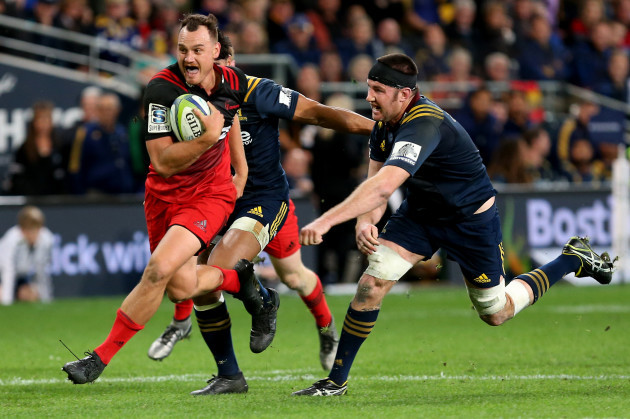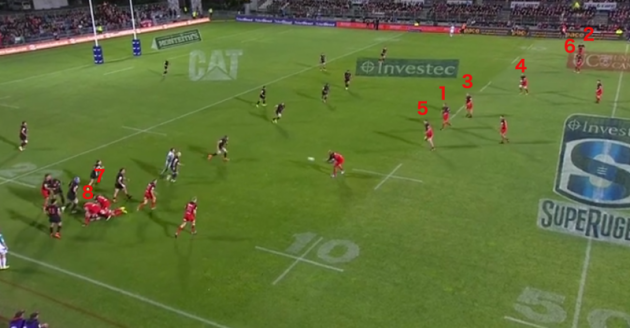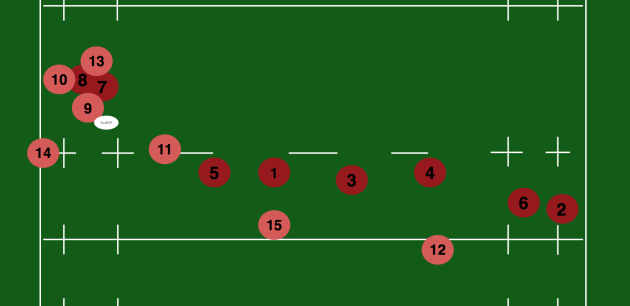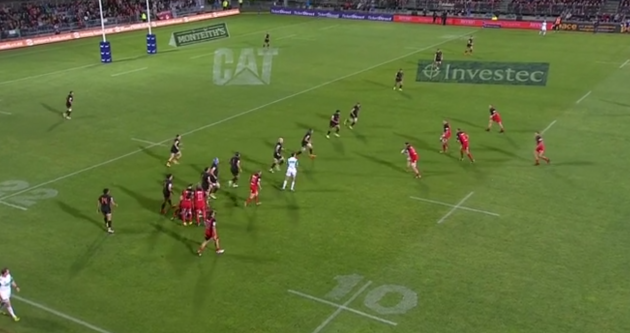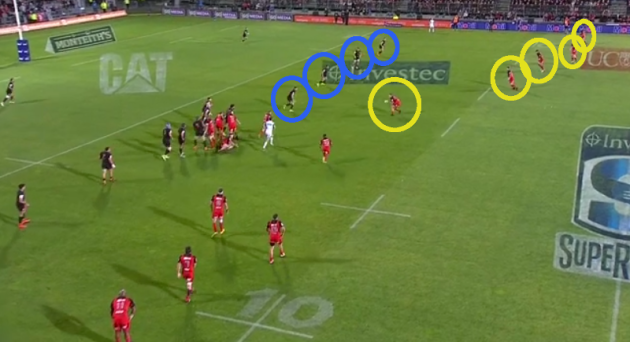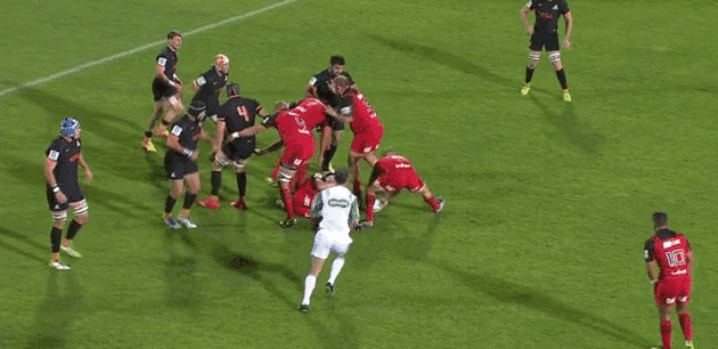DESPITE LAST WEEKEND’S defeat away to the ultra-clinical Highlanders, Todd Blackadder’s Crusaders remain top of Super Rugby’s New Zealand conference.
The Canterbury-based franchise, seven-times winners of the competition, have been a pleasure to watch so far this season, with their simple shape in phase play allowing a talented group of players to demonstrate the full range of their attacking skills.
The Crusaders – and Canterbury rugby – are known as the fathers of the 2-4-2 shape in rugby union, with this structure being a longstanding part of their tradition that is handed down from generation to generation.
We have studied Connacht’s ever-improving use of 2-4-2 under Pat Lam this season, but it’s on New Zealand’s south island that the structure originated in rugby union.
Blackadder is a Canterbury man born and bred, so it would have been a shock to see the Crusaders move away from this shape at any stage of his reign.
With Blackadder focusing on defence this season, attack coach Tabai Matson has been tasked with ensuring that their lofty standards don’t drop when the Crusaders have possession, and the results so far have been positive.
[image alt="Zones" src="http://cdn.thejournal.ie/media/2016/05/zones-630x335.png" width="630" height="335" title="" class="alignnone" /end]
Above we get an overview of the 2-4-2 shape on the pitch. With the backline players removed from the picture, it’s quite clear how the forward pack sets up in phase play.
Two players occupy the left-hand 15-metre channel, four forwards are in a central position and the other two members of the pack hold in the right-hand 15-metre channel.
With the Crusaders, the central pod of four forwards is almost always made up of the two props and two locks. That leaves the three back row players and the hooker to make up the two-player pods on either edge.
The set-up above, with the flankers in one wide pod and the number eight and hooker making up the other pod, is very common for the Crusaders but there is fluidity in all of this too.
For example, the set-up below could fall into place depending on where the possession has originated or what strike move the Crusaders have used off set-piece.
[image alt="Fluid Zones" src="http://cdn.thejournal.ie/media/2016/05/fluid-zones-2-630x372.png" width="630" height="372" title="" class="alignnone" /end]
Obviously, there are a number of other combinations of positioning that can occur and it’s notable how comfortable the Crusaders’ players are with that.
With many of them having been brought up with this shape as a central part of their rugby education, the majority of their players have an in-depth understanding of what is involved. Even when there are personnel changes to the starting XV, the system remains.
Many other teams around the world, including Bernard Jackman’s Grenoble and Lam’s Connacht, have adopted and adapted this shape to great effect, but the Crusaders are perhaps the most fluid 2-4-2 side of all.
It was fascinating to watch how Rob Penney’s attempts to introduce the 2-4-2 shape in Munster were met with reluctance and even criticism during the Canterbury man’s time in charge of the southern province. A clash of cultures perhaps.
When we discuss structure and shape in rugby, it can often be seen as something that restricts or inhibits players, but the very opposite is true in this case.
The Crusaders’ shape is a framework in which their individual skills and decision-making abilities can flourish. Their structure in attack means that the opposition is almost always stretched and stressed. Width is essential.
The use of two-player forward pods to hold that width means that the Crusaders are nearly always using the full lateral space of the field.
Every single Crusaders player has a strong understanding of the value of width in their attack and it’s extremely rare to see Blackadder’s men get narrow when in possession.
Let’s take a look at some examples of the Crusaders’ 2-4-2 shape stretching the opposition, allowing their individual skills and decision-making ability to flourish.
Highlander high standard
Below, we see Jordan Taufua cross to score against the Landers after a high-quality example of the 2-4-2 shape in action.
It’s notable that this passage of attack occurs around the opposition 22, where so many attacking sides become ultra narrow and ultra low-risk. Here, the Crusaders’ shape keeps the Highlanders stretched throughout.
In the opening phase of the clip, we see scrum-half Andy Ellis hit Richie Mo’unga, with that four-man pod to the out-half’s right.
[image alt="PIC 3" src="http://cdn.thejournal.ie/media/2016/05/pic-3-14-630x385.png" width="630" height="385" title="" class="alignnone" /end]
The first thing to note above is how stretched out the four-man forward pod is for the Crusaders in this particular instance. That happen every single time, but this is a good example of their desire for width in phase play.
Joe Moody [17], Owen Franks [3], Luke Romano [4] and Sam Whitelock [5] are all running vertical lines straight up the pitch outside Mo’unga.
As a result, we can see that the Highlanders’ midfield defence [marked in blue circles] must also stretch out to commit to these straight-running forwards.
Again, this is a crucial point. Many sides who have a desire for width in their play end up becoming very lateral in their attack, i.e. their players are all running diagonally across the pitch.
The Crusaders do, of course, do some of that but they straighten up better than most, allowing them to actually exploit space on the outside rather than allow the defence to drift across and cover it.
We also note the set of wide Highlanders defenders in the image above [marked in the yellow box]. They must hold wide because out of shot on the Crusaders’ right-hand edge, flankers Matt Todd and Taufua have held width along with centre David Havili.
[image alt="PIC 4" src="http://cdn.thejournal.ie/media/2016/05/pic-4-11-630x301.png" width="630" height="301" title="" class="alignnone" /end]
Above, we see the Crusaders’ set-up from overhead. The backs are marked in pink just so we can more clearly appreciate how the 2-4-2 shape of the forwards is functioning.
Kieran Read [8] and Codie Taylor [2] are involved in the ruck on the left-hand side with two backs, while the four-man pod is aligned outside Mo’unga. Over on the right, Todd [7] and Taufua [6] help to provide the width.
The shape outside Mo’unga means the Highlanders defenders have lots of players and space to cover and this puts a particular stress on hooker Ash Dixon, who commits outwards to the four-man pod just briefly enough for Mo’unga to dart through a gap.
The inside support of Ryan Crotty [22] is very useful too and this example underlines how the Crusaders’ backs are excellent at organising themselves around the 2-4-2 shape. Mo’unga’s break also demonstrates how the initial shape – stretching the defence – allows the individual player to read the situation, make a decision and execute with skill.
Mo’unga breaks and is able to find Franks with an offload as the pod around him floods through. Quick ball is moved to the left by Ellis for Dagg to carry and we see another advantage of the 2-4-2 shape.
[image alt="Ruck Resource" src="http://cdn.thejournal.ie/media/2016/05/ruck-resource-630x411.png" width="630" height="411" title="" class="alignnone" /end]
The positioning of players all the way across the pitch means the Crusaders generally have men in position to contribute to the life of the ball.
For the Mo’unga break, that meant having a player free to accept an offload, while above it means that Read and Taylor are in position to enter the breakdown after Dagg’s carry.
Rapid ruck ball is another pillar of the Crusaders’ game and their shape allows their players to be in good positions to show their skills in this area of the game too. Those skills often mean a ruthless, vicious and accurate clearout over the ball.
[image alt="PIC 6" src="http://cdn.thejournal.ie/media/2016/05/pic-6-5-630x380.png" width="630" height="380" title="" class="alignnone" /end]
The Crusaders come back from the left touchline and Ellis opts to skip Mo’unga this time to find Romano close to the posts. As we can see above, the All Blacks lock has a back-door option to find Crotty for a second-wave attack but, under pressure from Elliot Dixon, he makes a decision to retain the ball.
Moody and Franks are in prime position to ruck, even as Romano loses the collision.
As we can see above, only three forwards are involved but then it doesn’t make sense for Sam Whitelock [the fourth midfield forward] to sprint into that ruck as he can see that it’s going to be won. That doesn’t mean Whitelock switches off either, however.
On the very next phase, his handling is crucial as the Crusaders finally move the ball to the wide right channel where Todd and try-scorer Taufua make their presence felt.
[image alt="Leftover WhiteLock" src="http://cdn.thejournal.ie/media/2016/05/leftover-whitelock-630x318.gif" width="630" height="318" title="" class="alignnone" /end]
Many locks would carry in Whitelock’s position above, but the 27-year-old has the basic skill and appreciation of space to simply shift the ball on to Johnny McNicholl as the Highlanders struggle to cover the numbers.
Again, that patient holding of the width is essential for the Crusaders.
[image alt="PIC 8" src="http://cdn.thejournal.ie/media/2016/05/pic-8-4-630x378.png" width="630" height="378" title="" class="alignnone" /end]
Ben Smith and Patrick Osborne would love to be able to hammer up in the situation above, but the Crusaders’ numbers mean they can’t.
McNicholl, about to receive the ball, has three teammates outside him and the Highlanders’ outside defenders are forced to sit off as Malakai Fekitoa attempts to drift hard across the pitch and link with them.
Todd offers McNicholl a switch line to add another difficulty for Fekitoa, allowing McNicholl to dart at the Highlanders centre’s outside shoulder. Fekitoa, having been briefly distracted by Todd, is struggling and Smith cannot make a firm tackle as he turns back inside.
McNicholl, therefore, rides the tackle attempt and bounces out to offload to Taufua, who gets his reward for patiently waiting in the wings. It’s a lovely finish from the Crusaders in the sort of 4-on-3 scenario that they practice relentlessly in training.
Ultimately, the basic skill and decision-making ability is what counts most for Blackadder’s men, but their 2-4-2 shape facilities the execution.
Pouncing against Jaguares
In the clip below, we get another fine example of the Crusaders’ 2-4-2 shape helping them to create a try.
The score comes on fifth phase after a quick lineout near the Crusaders’ own 10-metre line and again demonstrates how intuitively they slip into shape and how effective their ability to hold width is.
With Mo’unga having hit the ruck wide on the left after a Read carry in that 15-metre channel, left wing Nemani Nadolo steps in as first receiver. It’s the Crusaders’ deep understanding of their structure that makes this an easier thing for the wing to do.
This sort of example is repeated time and time again in the Crusaders’ play.
From wings stepping in at first receiver, centres and wings swapping as the back-door option for the midfield pod of forwards, or props occasionally holding width on the outside edge, the Crusaders’ intuitive understanding of their structure means they are all comfortable in all positions.
Back to our example, from an overhead view with the backs now filled in, here’s how the Crusaders look.
The Crusaders carry in midfield through Moody [1], with Scott Barrett [5], Franks [3] and Romano [4] hitting the ruck.
Ellis, with options either side of that midfield ruck bounces back to the left and we see that Todd, with a carry, and Read, by rucking, contribute again as the two-man forward pod in that 15-metre channel.
Ellis comes to the right and the four-man pod, this time without a back linking, has organised itself rapidly.
That shape, combined with quick ruck ball, means the Jaguares are now chasing the ruck in defence and the Crusaders are ready to strike.
Again, Ellis has viable options either side here as the Crusaders use the full width of the pitch.
Ellis passes to Dagg at first receiver on the right and we can see that the Crusaders have five attackers [yellow] against the Jaguares’ four defenders [blue].
The Crusaders’ organised phase play has dragged the Argentinians around the pitch, fatiguing them and bringing about this situation in which the Kiwi side can strike. Again, we note how the Crusaders’ width concerns the defence and forces them to drift.
Dagg hits Crotty with a deliciously crisp pass – one of so many – and the All Black centre then uses his footwork to burst back to the inside of the hard-drifting Santiago González Iglesias, who is concerned about the presence of Taufua outside Crotty.
Essentially, we’re into unstructured rugby here as Crotty finds Dagg back inside, even though the opportunity comes partly because of the Crusaders’ structure.
They transition wonderfully well into a ruthless exploitation of the defensive frailty and that’s because they have the skills to do so.
Virtually every Crusaders player can catch, draw, pass, identify space and use their footwork to beat or at least wrong-foot defenders. Those core skills are the real story of their effectiveness, but the 2-4-2 shape allows them into situations like this one.
The quality of the passing across the board in this instance, out in front of the receiving player, as well as the superb support play from Dagg and Ellis, helps them to pounce on the opportunity.
Repeatability
Practice is the best way to get good at performing any action and the Crusaders’ shape is no different. Because their players are so accustomed to and comfortable in their 2-4-2 structure, they can focus on the implementation of their skills all the more.
Crucially, the Crusaders never become robotic in their structure and instead there is genuine fluidity in how they align themselves and attack the opposition, but also in their decision-making.
Above, we see Romano slip a clever tip-on pass to Wyatt Crockett for a midfield bust.
There are countless examples of their shape helping the Crusaders players’ skills to flourish, although there are also times they get it wrong. In the clip above, for example, they would have been frustrated by the inability to take the chance on the left edge after Crockett’s break, even if they do score three points with penalty advantage being played.
However, Blackadder’s men have utter faith in their ability to cut teams apart when they are accurate and effective in their basic skills and decision-making.
Some hugely challenging tests lie ahead for the Crusaders this season, but their shape should continue to allow those core skills to come to the fore.
The42 is on Snapchat! Tap the button below on your phone to add!
